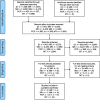Potential Impact of Co-Infections and Co-Morbidities Prevalent in Africa on Influenza Severity and Frequency: A Systematic Review
- PMID: 26068416
- PMCID: PMC4466242
- DOI: 10.1371/journal.pone.0128580
Potential Impact of Co-Infections and Co-Morbidities Prevalent in Africa on Influenza Severity and Frequency: A Systematic Review
Abstract
Infectious diseases and underlying medical conditions common to Africa may affect influenza frequency and severity. We conducted a systematic review of published studies on influenza and the following co-infections or co-morbidities that are prevalent in Africa: dengue, malaria, measles, meningococcus, Pneumocystis jirovecii pneumonia (PCP), hemoglobinopathies, and malnutrition. Articles were identified except for influenza and PCP. Very few studies were from Africa. Sickle cell disease, dengue, and measles co-infection were found to increase the severity of influenza disease, though this is based on few studies of dengue and measles and the measles study was of low quality. The frequency of influenza was increased among patients with sickle cell disease. Influenza infection increased the frequency of meningococcal disease. Studies on malaria and malnutrition found mixed results. Age-adjusted morbidity and mortality from influenza may be more common in Africa because infections and diseases common in the region lead to more severe outcomes and increase the influenza burden. However, gaps exist in our knowledge about these interactions.
Conflict of interest statement
Figures
References
-
- Centers for Disease Control and Prevention. Influenza outbreak—Madagascar, July-August 2002. MMWR Morb Moral Wkly Rep. 2002;51(45):1016–8. - PubMed
-
- Influenza outbreak in the district of Bosobolo, Democratic Republic of the Congo, November-December 2002. Wkly Epidemiol Rec. 2003;78(13):94–6. - PubMed
Publication types
MeSH terms
LinkOut - more resources
Full Text Sources
Other Literature Sources
Medical


